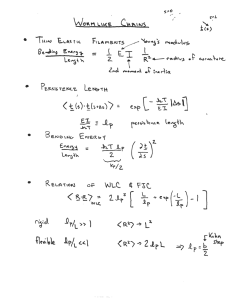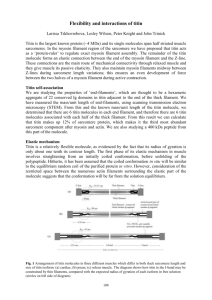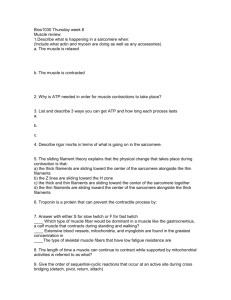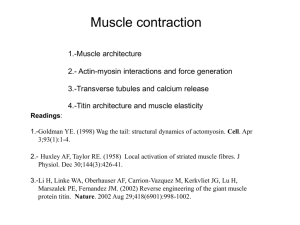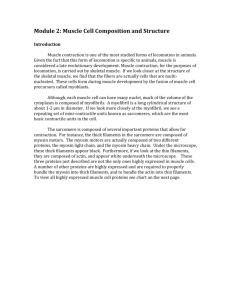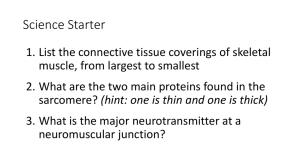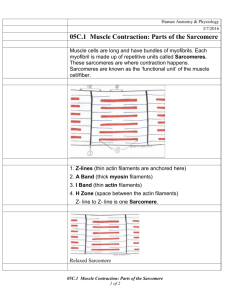3.014 Materials Laboratory October 13-19, Fall 2006 α
advertisement
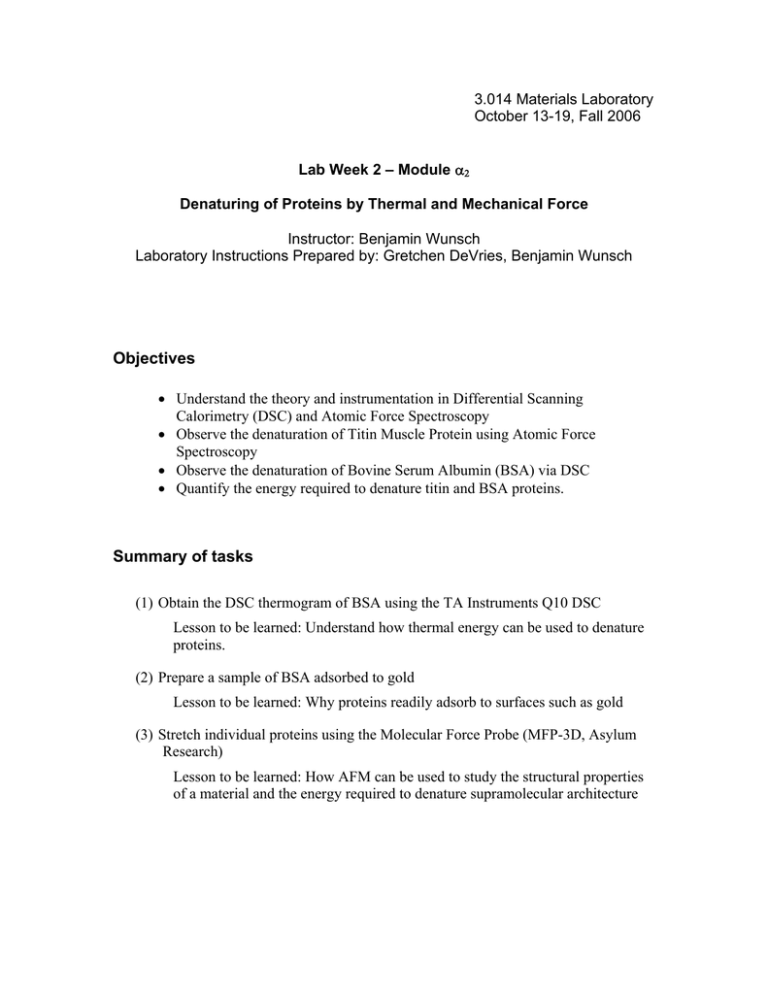
3.014 Materials Laboratory October 13-19, Fall 2006 Lab Week 2 – Module α2 Denaturing of Proteins by Thermal and Mechanical Force Instructor: Benjamin Wunsch Laboratory Instructions Prepared by: Gretchen DeVries, Benjamin Wunsch Objectives • Understand the theory and instrumentation in Differential Scanning Calorimetry (DSC) and Atomic Force Spectroscopy • Observe the denaturation of Titin Muscle Protein using Atomic Force Spectroscopy • Observe the denaturation of Bovine Serum Albumin (BSA) via DSC • Quantify the energy required to denature titin and BSA proteins. Summary of tasks (1) Obtain the DSC thermogram of BSA using the TA Instruments Q10 DSC Lesson to be learned: Understand how thermal energy can be used to denature proteins. (2) Prepare a sample of BSA adsorbed to gold Lesson to be learned: Why proteins readily adsorb to surfaces such as gold (3) Stretch individual proteins using the Molecular Force Probe (MFP-3D, Asylum Research) Lesson to be learned: How AFM can be used to study the structural properties of a material and the energy required to denature supramolecular architecture Introduction As was discussed in 3.012, a great deal about the thermodynamic properties of a material can be learned by studying its behavior in response to heat and various forms of work. In this laboratory experience, we will study the energetics of denaturation (unfolding) of a protein in response to heat and mechanical force. By doing so, we will be able to quantify the enthalpy associated with the phase transition of the protein from the folded to the unfolded state. The protein we will use is bovine serum albumin (BSA), a protein found in cow blood. Albumins are present in the blood of many mammals and typically are among the most abundant proteins in the bloodstream. BSA exists in its native folded state at room temperature under “biological” conditions; that is, in water of a fairly neutral pH. To mimic this environment, we will dissolve BSA in a buffer solution (phosphate buffered saline, PBS) with ionic strength 1.0 M and pH 7.4. Thermal denaturation of BSA will occur in a differential scanning calorimeter (DSC). We will obtain a thermogram that depicts the heat flow into or out of the sample as the temperature is increased at a set rate. Above some given temperature, the bonds holding BSA together will be broken and the protein will denature. We will observe this as a peak on the thermogram, and from this data we will determine the enthalpy of denaturation. We also will deposit a layer of titin onto a gold surface and attempt to mechanically denature the protein by physically pulling it apart. Using an atomic force microscope (AFM) as a molecular force probe (MFP), we will “grab” onto individual proteins and extend them. When the protein reaches a certain extension, it will no longer be able to elastically deform, and the secondary bonds giving it its structure will have to break. Experimental techniques Differential scanning calorimetry (DSC) DSC is a technique to measure the heat flow into or out of a sample (relative to a reference sample) as a function of temperature. By measuring the amount of heat a sample absorbs or releases (ΔH) as we change the temperature (T) at a constant rate, we can directly determine thermodynamic quantities such as:1,2 • The enthalpy of melting, ΔHm (and that of other phase transitions) • The temperatures of various phase transitions (e.g. solidÆliquid, liquidÆvapor, and vice versa), as well as the crystallization and glass transition temperatures (Tc and Tg, respectively) of polymers • The thermal degradation temperature Why is ΔH the relevant thermodynamic variable in this situation? Consider the definition of ΔH: dH = TdS + VdP . Enthalpy is the change in energy of a system operating under pressure dP. The TdS term quantifies the energy in the system that is irrecoverable; it has been turned into heat that cannot be used for work. At constant pressure, we find that dH = TdS = dq ΔH = ∫ dH = q . Thus, the enthalpy change is directly related to the heat flow in a system, which is what we measure with DSC. Most of the thermodynamic quantities accessible by DSC are associated with phase transitions, such as melting. Recall from class that the change in enthalpy upon melting is known as the enthalpy of melting, ΔHm, and that there is a discontinuity in the enthalpy at the solid-liquid phase transition. More practically, consider what happens to ice when it is heated at a constant rate. At first, its temperature rises as it is heated. When it reaches its melting temperature, Tm, the ice begins to melt and become liquid water. However, until the entire sample has melted, the temperature does not rise above Tm even though heat is still being added to the system. Only once the entire sample has become liquid does the temperature rise again. This is because heat is required to overcome the energetic barrier between the two phases and drive the solidÆliquid phase transition. In DSC, the temperature of a sample is increased (or decreased) at a constant rate, and the heat flow into (or out of) the sample in order to maintain that rate is measured. In our above example, the heat flow is constant until we reach Tm. Then, a large amount of heat must be added in order to melt all the ice and maintain the imposed rate of temperature increase. Thus, the DSC will detect an endothermic peak (energy being put into the system) in the heat flow at Tm, from which we can calculate the enthalpy of melting. A typical DSC curve of a crystalline polymeric material such as high density Heat Flow (mW) Exothermic Endothermic polyethylene (HDPE), for example, would look like: Tc Tm Tg Temperature (oC) Figure by MIT OCW. where Tm is the melting temperature, Tc is the crystallization temperature, and Tg is the glass transition temperature. Exothermic peaks, such as that of crystallization, point down, indicating that energy is being released from the sample. Endothermic peaks, such as those associated with melting, are positive because energy is being put into the sample. Interpreting the DSC Curve3 Zero Line: the curve obtained by running through the heating cycle with the instrument empty Baseline: The line constructed in such a way that it connects the measured curve before and after a peak Peak: Deviation from the baseline as a result of disruption of steady state by some production or consumption of heat by the sample Initial Peak Temperature, Ti: The T at which the curve begins to deviate from the baseline Extrapolated Peak Onset Temperature, Te: The T at which a line drawn through the almost linear section of the ascending peak slope intersects the baseline Extrapolated Peak Completion Temperature, Tc: The T at which a line drawn through the almost linear section of the descending peak slope intersects the baseline Final Peak Temperature: The T at which the curve returns to the baseline General notes about data interpretation: • Positive peaks are endothermic (a positive amount of energy is being put into the sample), and negative peaks are exothermic. • Endothermic peaks (melting, solid-solid transitions, e.g.) are often reversible on cooling; exothermic peaks (crystallization, decomposition) are not. • The enthalpy of a phase transition (ΔH) can be determined by integrating the peak. • Crystallization is not instantaneous; parts of the sample begin to crystallize before others, and so the magnitude of the exothermic peak of crystallization is ratedependent. Often it take an asymmetric shape, tailing off to the baseline as crystallization is completed. To calculate the heat capacity Cp and the entropy change ΔS, you must use the initial and final peak temperatures and the area under the peak: ⎧ T2 ⎪ΔH = ∫ C p dT T1 ⎪⎪ Cp: ⎨ΔH = C p (T2 − T1 ) ⎪ ⎪C p = ΔH (T2 − T1 ) ⎩⎪ T2 Cp T1 T ΔS = ∫ dT = C p ln(T2 − T1 ) To calculate ΔG of transition, you must use the peak temperature, the ΔH from the thermogram, and the ΔS from calculations as given above: ΔG = ΔH − T ΔS Atomic Force Spectroscopy The atomic force microscope (AFM) is used for nanometer-scale topographic imaging of surfaces. In AFM, a microfabricated cantilever (Figure 2) is scanned across a surface, bending in response to nanometer-scale changes in surface topography. A focused laser beam is reflected off the backside of the cantilever and directed into a positionsensitive photodetector (PSPD). As the cantilever deflects, the laser beam strikes different points on the PSPD. The vertical sensor output difference, s (V), of the top minus bottom quadrants of the PSPD is used to measure cantilever deflection, δ (nm). δ is then converted into height data, producing a topographic profile, or “contour Courtesy of Veeco Instruments, Inc. Used with permission.. Figure 2 An SEM micrograph of a typical AFM cantilever. (Veeco Instruments, http://www.veecoprobes.com) map”, of the surface. Atomic force spectroscopy measures atomic-level forces between a fine probe tip and an underlying substrate, as a function of tip-sample separation distance, D (nm). In this case, the cantilever is driven vertically by a piezoelectric crystal, which expands or contracts in response to an applied voltage. Deflection data is collected as the cantilever approaches and retracts from the surface. In this case, δ is converted into the force, F (nN), that is exerted on the sample by the cantilever or vice versa. The expansion and contraction of the piezo crystal, z (nm), is converted into the tip-sample separation D. The result is a plot of the tip-sample interaction force versus the tip-sample distance. This procedure is known as high-resolution force spectroscopy (HRFS).4 A typical HRFS experiment on a hard substrate is depicted in Figure 3. The raw data is seen on the left; it consists of two curves, one for the approach and one for the retraction of the tip. At large separations, there are no interactions between tip and sample, the cantilever does not deflect, and there is no measured PSPD output. When the tip nears the sample, it begins to bend and a signal is detected on the PSPD. As the tip is retracted, often there are adhesive forces between the tip and the sample that will cause it to bend the other way and stay in contact with the surface for longer. This gives rise to the region of negative PSPD output. At some point, the piezo crystal has raised the tip so far that the attractive forces are not enough to keep it in contact with the sample, and it returns to its undisturbed, un-deflected state. Conversion of this data produces the plot seen on the right (see below for data conversion procedure). From this force vs. distance plot, tipsample interaction forces and system energetics can be determined. Diagrams removed due to copyright restrictions. Figure 3 Raw and converted data from a force pull depicted at right. It should be noted that in all HRFS experiments, the spring constant of the cantilever, k, is much less than the stiffness of the sample. Hence, little or no deformation of the substrate occurs, leading to the D = 0 vertical region of apparent infinite slope in the high-force, constant compliance regime. To take a thermodynamic approach to this experiment, consider that we are performing mechanical work on the system. Our intensive/extensive pair of coupled variables is force and displacement, giving us incremental work dW = F ⋅ dl . This framework now enables us to write and determine relevant thermodynamic expressions. Procedure for data conversion To convert the y-axis from PSPD output (s (V)) to Force (nN): 1. δ ( nm) = − s(V ) m(V / nm) where m is the slope of the raw data curve in the constant compliance regime (e.g. when the tip and sample are in contact) 2. By Hooke’s law, F ( nN ) = k ( nN / nm) ⋅ δ ( nm) where k, the spring constant of the cantilever, is an experimentally measured quantity. To convert the x-axis from z-piezo deflection (z (nm)) to tip-sample separation distance (D (nm)) is simpler: D = z + δ where δ is calculated in step 1 above. To determine the energy supplied to the system, calculate the area enclosed by the “adhesion triangle” of the force-distance plot (e.g., integrate that portion of the curve). Protein structure Proteins are biopolymers composed of amino acids. A typical protein possesses the basic structure: R * * N H O where “R” is a chemical group such as -CH3, -COOH, etc. There are typically hundreds to thousands of amino acids per protein, each amino acid being referred to as residue of the protein. Every function in the living cell depends on proteins, including but not limited to: • Motion and locomotion of cells and organisms depends on contractile proteins. • The catalysis of all biochemical reactions is done by enzymes, which contain protein. • The structure of cells, and the extracellular matrix in which they are embedded, is largely made of protein. (Plants and many microbes depend more on carbohydrates, e.g., cellulose, for support, but these are synthesized by enzymes.) • The transport of materials in body fluids depends on proteins. • The receptors for hormones and other signaling molecules are proteins. • The transcription factors that turn genes on and off to guide the differentiation of the cell and its later responsiveness to signals reaching it are proteins. There are four levels of structure identified with proteins: primary, secondary, tertiary and quaternary. The primary structure of proteins is the specific sequence of amino acids. In the “native” state, proteins fold into specific three-dimensional structures that are determined by the amino acid sequence; examples of common structures are twisted alpha-helices (Figure 4, left) or crimped beta-sheets (Figure 4, right). The folded structures are held together by secondary bonds, such as hydrophobic interactions, hydrogen bonding, or electrostatic interactions. This morphology is known as the secondary structure. Several helicies and sheets, along with unfolded segments of protein, can then fold into more complicated structures, such as cavities, globules or rods. This complex three-dimensional shape is called the tertiary structure. A final structure, the quaternary structure, represents the packing of various proteins into crystals or complexes. Why do proteins fold in this way? The amino acids that compose proteins may be either hydrophilic (energetically favorable interaction with water) or hydrophobic (energetically unfavorable interaction with water). Recall that in investigating an energetically driven phenomenon, we always want to minimize the Gibb’s free energy. In this case, there is an entropic penalty of folding into tight, ordered structures. However, this is overcome by the enthalpic gains of folding in such a way that the hydrophobic residues are not exposed to aqueous biological environments. However, the secondary bonds keeping the three-dimensional structure of the protein are easily broken by the application of external forces. This is called denaturation. For example, thermal energy can overcome weak intramolecular interactions, causing protein unfolding. Similarly, mechanical force can physically “pull apart” a protein and unravel its secondary structure. Figure 4 Left: the structure of a polypeptide α-helix. Right: the structure of a polypeptide βsheet (Adapted from reference 5). Courtesy of Natural Toxins Research Center. Used with permission. Some proteins possess rather unique, modular, supramolecular structures. For example, the giant muscle protein titin possesses some ten “domains” of tightly ordered structure that are linked together by amino acid “strings” of random structure, much like pearls on a necklace. Mechanically, in tension, these domains behave like springs in series, so if the protein is extended, the weakest spring (or domain) will unfold (denature) first, followed by the next weakest, and so on.6 If we had nano-sized fingers and could pull on titin, we would feel the tension in it suddenly release every time we unfolded another domain. Atomic force spectroscopy does just that by “grabbing” individual proteins with an AFM cantilever and extending them. Such an experiment on titin is shown in Figure 5. At first, as the cantilever retracts, we see only elastic stretching of the protein. However, because this is a modular protein, at some given force (that is characteristic of the protein being studied), the protein unfolds, relaxing the stretching force and generating a negative peak in the force plot. Multiple unfolding events generate a sawtooth pattern.8 In addition, proteins will denature with heat. As thermal energy increases, the magnitude of molecular vibrations and the range of bond rotations both increase, vibrations allowing a greater number of molecular conformations to be sampled by the protein. At some point, the thermal Courtesy of J. M. Fernandez. Used with permission. energy overcomes the enthalpic driving force maintaining the protein in its complicated supramolecular structure, and the protein “melts”. Using DSC, we can measure the ΔH per gram of this phase transition, and convert it into Figure 5 (a) Schematic of the modular unfolding of the protein titin. (b) Force-extension curve of titin shows a peaks corresponding to each successive unfolding event. (Adapted from reference 7) the energy of denaturation per molecule or per mole.(A similar conversion can be done on the energy obtained from integrating the force spectroscopy data, thus enabling us to compare the denaturation energies obtained by each method.) Muscle Structure and the Titin Protein Muscle is a tissue formed from complex arrays of muscle cells, and is the primary means of locomotion and mobility in vertebrates and several invertebrates. Muscle tissue is contractile, meaning that it only can pull in on itself; muscles are not designed to extend as means of generating force. The machinery for contraction is built from a hierarchy of micro and nanoscale assembiles. In each muscle cell are thousands of aligned fibers which cross from one axis of the cell to the other. Each fiber is 20-80 microns in diameter and is coated by a layer known as the sarcolemma, which regulates nutrient intake and neural signaling. Figure by MIT OCW. Figure 6. Schematic of muscle fiber structure. Each fiber is composed of hundreds of fibrils, or myofibrils, which house the main components of muscle contraction. Each fibril is composed of segments of dark and light bands which can be seen under a high resolution microscope. The stretches of fibril between different bands are labeled as reference, the most important region being the distance between two Z lines (see Figure), which is called the sarcomere. The sarcomere is composed of two sets of filaments, thick and thin, with the thick filaments in the center of the sarcomer (forming the A band) and the thin filaments extending from the Z line into the thick filaments (forming the I band). Courtesy of National Skeletal Muscle Research Center. Used with permission. Figure 7 Taken from http://muscle.ucsd.edu/musintro, Muscle Physiology, National Skeletal Muscle Research Center, San Diego, CA. The thick filaments can be seen to have small brittles known as cross-bridges which give them their darker appearance. The thick filaments are assemblies of the protein myosin; the thin filaments are assemblies of the protein actin, along with other constitutents (troponin, tropomyosin, phosphogens, components we’re not concerned with here). The cross-bridges are part of the myosin protein, and are composed of two globules of folded protein. It is important to know that the cross-bridge protein carries the reaction centers which can transform chemical energy into mechanical work. Figure 8 Schematic of a sarcomere, showing the myosin and actin filaments. Under resting conditions the myosin and actin do not interact, due to a set of blocking molecules on the actin surface, and the muscle remains in stasis. When a neural signal is received, this sets off a series of reactions which culminate in the removal of the blocking molecules on actin. Once the actin is exposed the myosin filaments with their cross-bridges can anchor onto the actin filaments. The myosin cross-bridges then consume chemical energy, in the form of adenosine triphosphate (ATP), which induces a change in shape in the protein structure. This shape change is a transduction event (transformation of energy from one type (chemical) to another (mechanical) ) and generates a force between the myosin and actin, causing the actin filament to slide inward. This process takes on the order of milliseconds, are repeats thousands of times, causing the sarcomere to contract inward as the actin filaments are pulled inward. An analogy of the motion is to think of pulling a rope hand over hand, with each tug drawing the rope in a little more. The contraction of each sarcomere shortens the fiber length, and in turn contracts the muscle cells and the muscle tissue. These biological assemblies are the basis for normal muscle motion. The muscle system is designed for contractile motion; if an extension force (a tension) is applied, the myosin/actin filaments generate a resistance by the continuous contracting with the myosin cross-bridges. However, if the extension force reaches the ultimate strength of the muscle fibers, the sarcomere is pulled apart. This destroys the alignment of the filaments, and damages the array of biomolecules that maintaine the muscle tissue. To prevent over-extension, biology has developed a different set of proteins to protect the sarcomere, the most important of these protines being titin (pronounced like titan, a.k.a. connectin). Titin is a large protein, approximately 1 μm in length, composed of 26,926 amino acids (the normal range is 200-1000 for a protein) and weights 3.5 MDa 1 . The titin molecule extends from the Z line to the middle of the sarcomere (within the A band, to what is known as the M line). Titin is designed to handle overextension of muscles by providing dynamic elasticity in what is termed passive tension. Passive tension is the type of mechanical resistance found in elastic systems, such as a stretched spring that develops an internal stress which tries to restore the spring to rest. This internal stress is 1 Da is for Dalton which is the biology way of saying molecular weight (g/mol) a passive tension, since it is trying to “pull” the spring inward. Springs generate stress by deforming, and thus pulling on their atomic bonding; titin functions in the same way by unraveling as force is applied; this unraveling is the equivalent of denaturing. The unraveling of the protein consumes energy and provides resistance against overextension of the sarcomere. The major bulk of the titin protein is composed of repeating sections of protein, or domains, which are called immunoglobulin type regions. Immunoglobuin (Ig), as its name suggests, is a class of proteins that operates in the immune system. Study of the structure of titin has found that many of it’s domains resemble the Ig in structure. These domains are linked in series and form much of the length of the protein. When titin is stressed, the molecule beings to unravel (denature) one Ig domain at a time. This stepwise response is what gives titin it’s unique force pulling response. Once the external stress is removed, the titin molecule restores to its original length (folding), resetting the sarcomere’s functional size. Thus, titin protects the sarcomere from being destroyed by extension forces. It should be stated that the above description is not the whole story for titin, several other domains within the protein give different types of passive tension depending on the severity of the extension force, making the titin molecule a very dynamic and adaptable spring-system. Worm-Like Chain Model and Atomic Force Pulling Data Analysis The force response of the titin molecule as will be observed in the experiment exhibits a well defined saw-tooth pattern with a sweeping curve that reaches a maximum that quickly drops back to the baseline. This curve is characteristic for a class of polymers in which the polymer residues (mers, individual molecular components) are considered rigid but capable of rotating with respect to one another. This is in contrast to a molecule which can be considered flexible like a string. To describe these rigid polymers, the worm-like chaing (WLC) model is used. This model assumes that each residue is fixed in length and can only rotate in certain fixed gyrations. Physical properties of a WLC polymer can be obtained by calculating the statistics of these rigid systems (e.g. average distance the polymer remains unbent, the average distance between the two ends, the amount of energy needed to rotate a segment, etc.) For a WLC type polymer, the force response F (x ) is given by11: kT F ( x) = b −2 ⎛ ⎞ ⎜ 0.25⎡1 − x ⎤ − 0.25 + x ⎟ ⎢⎣ L ⎥⎦ ⎜ L ⎟⎠ ⎝ Where k is the Boltzmann constant (8.13x10-23 J/K), T is temperature, x is the extension distance (average length of the coiled up polymer as its being unraveled), b is the persistence length and L is the contour length. The persistent length is a measure of the stiffness of the polymer, it gives the average distance over which the polymer remains a rigid rod. For example if a WLC polymer has a persistence length b = 1 nm this implies on average the polymer bends every 1 nm, between bends it remains relatively straight and rigid. The contour length is the distance between the two ends of the polymer when fully extended. Thus by fitting the WLC force response to a given polymer, you can obtain information about its maximum length (L) and stiffness (b). You might ask, what exactly is the force response plotting? The force response models what happens to the WLC polymer as you pull on its two ends. The polymer resists tension, and the stiffer the polymer, the more force is necessary to unravel it, hence the appearance of the persistence length and contour length parameters. The WLC model allows us to calculate the amount of energy absorbed in a single Ig domain denaturing. To analyze the data taken from the atomic force microscope, you should curve fit the WLC model to the obtained data (ideally for every peak you obtain, but you can also do it for one or two). Curve fitting can be done automatically with software such as Mathmatica, MatLab, Origin or MathCad. Alternatively you can make the assumption that at the maximum of the force peak the extension is equal to the contour length L. From this you can then calculate the persistent length b, however you’ll probably have to iterate this process to get a good fit. Once you have the WLC force response, you can use simple calculus to get the energy of denaturation for that domain EIg. The summation of all EIg for the force response is our denaturation energ for the entire titin segment. REFERENCES (1) Ramakumar, K. L.; Saxena, M. K.; Deb, S. B. Experimental evaluation of procedures for heat capacity measurement by differential scanning calorimety. J. Thermal Anal. and Calorimetry 66, 387-397 (2001). (2) Brown, M. E. An Introduction to Thermal Analysis: Techniques and Applications, Eds.; Kluwer Academic Publishers: Dordrecht, The Netherlands, 2001. (3) Skoog, D.A., Holler, F.J., Hieman, T.A. Principles of Instrumental Analysis, 5th ed. Harcourt Brace & Company: Philadelphia, 1998. (4) Rixman, M. A., Dean, D., Macias, C. E. and Ortiz, C. Nanoscale intermolecular interactions between human serum albumin and alkanethiol self-assembled monolayers. Langmuir 19, 6202-6218 (2003). (5) Natural Toxins Research Center at Texas A&M University - Kingsville. (6) Erickson, H. P. Science 276, 1090-1092 (1997). (7) Fernandez, J. M. Fernandez Homepage : Research Highlights. Columbia University: http://www.columbia.edu/cu/biology/faculty/fernandez/FernandezLabWebsite/index. html (accessed October 2005). (8) Fisher T.E., Oberhauser A.F., Carrion-Vazquez M., et al. The study of protein mechanics with the atomic force microscope. Trends in Biochemical Sciences 24, 379-384 (1999). (9) Ratner, B.D., Hoffman, A.S., Schoen, F.J., Lemons, J.E., An Introduction to Materials in Medicine. Academic Press: San Diego, 1996 (10) Encyclopedia Britannica, 15th Edition, Volume 24, pg 452-479. (11) Rief M., Gautel M., Oesterhelt F., Fernandez JM., Gaub HE., Reversible Unfolding of Individual Titin Immunoglobulin Domains by AFM. Science 276, 1109-1112 (1997). (12) Li H., Link WA., Oberhauser AF., Carrion-Vazquez M., Kerkvilet JG., Lu H., Marszalek PE., Fernandez JM., Reverse engineering of the giant muscle protein titin. Nature 418, 998-1002 (2002). (13) Marszalek PE., Lu H., Li H., Carrion-Vazquez M., Oberhauser AF., Schulten K., Fernandez JM., Mechanical unfolding intermediates in titin modules. Nature 402, 100-103 (1999). (14) Oberhauser AF., Hansma PK., Carrion-Vazquez M., Fernandez JM., Stepwise unfolding of titin under force-clamp atomic force microscopy. Proceedings of the National Academy of Sciences 98 (2) 468-472 (2001).
